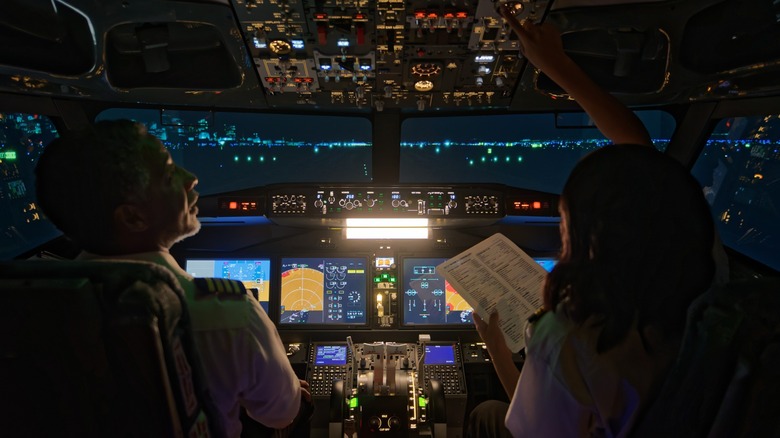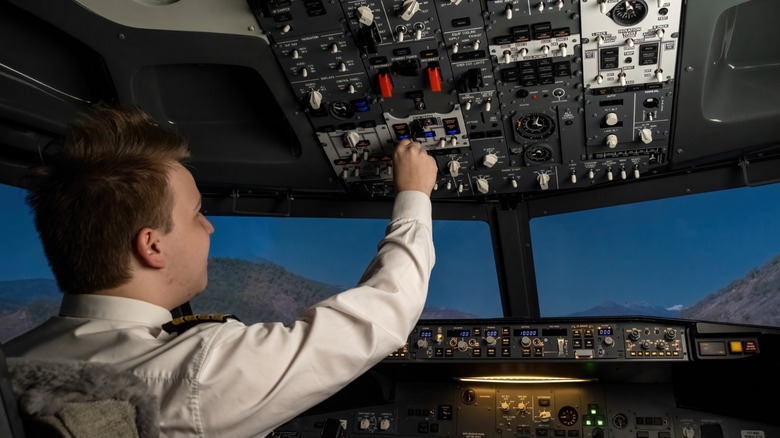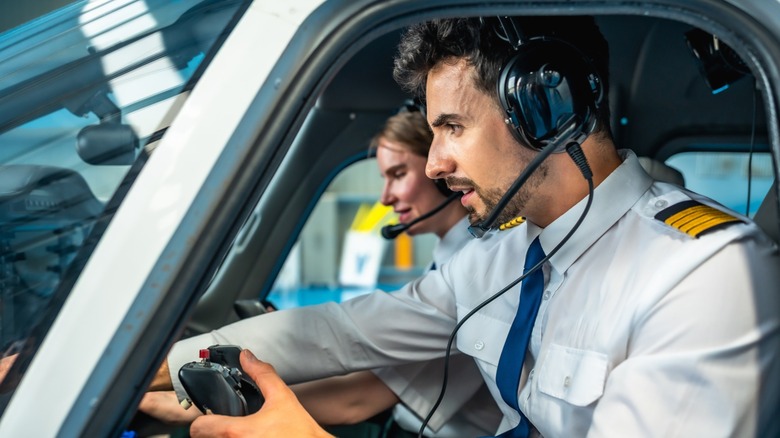How Do Pilots See At Night? What You Should Know About Flying In The Dark
If you've ever looked up at the night sky at the sound of a passing plane, you may have noticed a small blinking red light. That's called an anti-collision beacon, and while it might seem minor from the ground, it plays a big role in making nighttime flying safer. Now, airplanes may not use headlights in the exact same way as cars, and the skies certainly don't come with streetlights but lighting still plays a major role in how pilots operate in the dark.
It all starts on the ground level. Runways and taxiways are illuminated with carefully arranged lights to help pilots line up, taxi, and take off safely. Inside the cockpit, the instrument panels are softly backlit, giving pilots a clear view of essential readings without compromising their night vision. So even before they leave the tarmac, there's a good amount of visual support to help them stay oriented. But once a plane lifts off and climbs into open airspace, things get tricky. The higher you go, and the darker it gets, the harder it becomes to make out terrain.
On top of that, your sense of depth fades, city lights on the ground can blur into confusing patterns, and sometimes reflections or isolated lights seem to move or shift when they're not. These optical illusions can mess with a pilot's perception of altitude or distance. That's why pilots are trained to anticipate those illusions and not trust their eyes alone. Instead, they rely on flight instruments – tools like the attitude indicator, altimeter, and heading display — to paint a clearer, more objective picture of the aircraft's position and speed.
What helps pilots see in the dark?
First of all, pilots generally define night as the stretch of time between one hour after sunset and one hour before sunrise. That extra hour on either end accounts for something called civil twilight, when the sun has dipped below the horizon but still reflects light into the atmosphere. During this period, there's usually enough ambient light to make out the horizon and surrounding terrain. But once that light fades completely, pilots shift from visual cues to instruments and advanced tech to keep the aircraft on course.
They rely on a mix of traditional and modern navigation tools, including VORs (Very High Frequency Omnidirectional Range stations) and GPS systems. Many aircraft also come equipped with infrared-enhanced vision systems that pull in topographic data and thermal imaging to digitally reconstruct the terrain on screen. Others offer a full hemispherical view of the airspace ahead. The goal in all cases is to help the pilot maintain a strong sense of orientation: where the aircraft is, how fast it's moving, and where the ground is in relation to the wings. And that anti-collision beacon we mentioned earlier helps other pilots sharing the same airspace spot the aircraft in time to avoid a crash.
But even with all the tech onboard, pilots also communicate with air traffic control (ATC), for real-time updates on traffic, runway changes, and shifting weather conditions. It'd be a pilot deviation not to. Physiology is another area the Federal Aviation Administration (FAA) takes into consideration. At higher altitudes, the reduced oxygen levels can affect a pilot's vision, a condition known as mild hypoxia. That's why it's recommended that pilots use supplemental oxygen during night flights above 5,000 feet.
How are pilots trained to fly at night?
One of the things pilots wish you knew about their job is how complex it is to become certified. In the U.S., the FAA requires private pilot candidates to log a minimum of three hours of night flight, including at least 10 takeoffs and landings after sunset. During this time, students learn to fly without the visual landmarks that make daytime flying relatively easier. But even after earning their license, pilots aren't cleared to fly at night unconditionally . The pilot in command must have completed at least three takeoffs and three landings to a full stop at night within 90 days — although these operations can take place in a simulator.
Night training also covers how to adjust the body's natural tendencies. For instance, because the center of the retina doesn't perform well in low light, pilots are taught to use off-center scanning, which means looking slightly to the side of an object rather than directly at it. They also learn to protect their night vision by avoiding sudden exposure to bright light, which can take more than 30 minutes to recover from. And then there's fatigue. Since our bodies are naturally wired to relax at night, what happens if the pilot feels sleepy?
Well, before you panic, know that pilots are encouraged to rest well before each flight so they can stay alert. But on long-haul commercial flights, those lasting more than eight hours, pilots are actually allowed to rest briefly. Most of the flying at cruising altitude is done on autopilot anyway, and so the cockpit crew can take turns, following a regulated rest schedule. A huge part of flying in general, is preparing for what could go wrong. When an emergency occurs, pilots are trained to stay calm and respond quickly.


